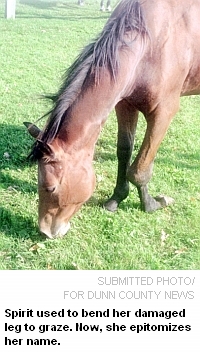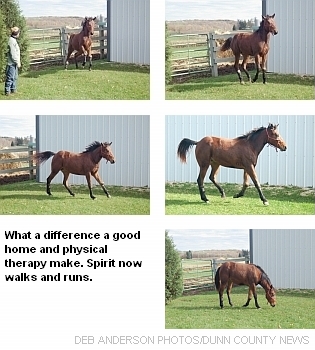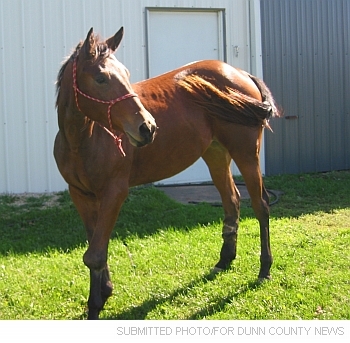A new 'Spirit'
At the close of evening chores, I stopped at the doors of the old barn. Something was different. Someone had been in the barn. I could feel it. Couldn't see anything, but I knew - absolutely knew - that someone had been in that barn. My nostrils were working hard and my eyes started squinting. Who had been in the barn?
Then I spotted the difference. The door to one of the box stalls was closed. Who would do that? Going up to the stall door, my face registered my anger. Inside that stall were two little brown ears sticking up. Now who in the world put Gracie up here in the box stall? Who was moving my horses around?
I flung open the door as if the human culprit would be hiding in the stall with Gracie. But unfamiliar brown eyes met mine. Ears that weren't Gracie's came forward. A strange nose with a button scar smelled me. And I asked, fully expecting her to explain to me, "Now, who are you?"
My mind flew and I tried to understand just what had happened here. She was a year, maybe a bit more, stunted in her growth, ribs showing, hipbones sticking out a bit. She had long back legs, and a cute little face with that button scar on the very end of her nose. Was that short mane from other horses chewing on her, or from her rubbing?
I reached out and touched her and she was as calm as could be.
"Who are you, little girl?" I asked. "How did you get here? When did you show up? Did someone just leave you here?"
Someone had dropped this horse off and put her in here knowing I would find her. No note in the mailbox. No note on the porch or anywhere in the barn with her. No note in the horse trailer or stuck in any of the doors. No note at all. Just her old lead rope left on the door to the stall. I could see her legs and knew why, too. This was a three-legged horse.
I spent the next 90 minutes going over every inch of her. Her left front chest was very underdeveloped. Her body was probably 60 to 70 percent of what it should be for a horse her age. She was hungry - eating anything and everything around her. And she drank like water had been scarce. As for her hind legs, well, one side was perfect and dainty and quick as lightning! The other, however, was far from normal: It was scarred and huge and scabby and dirty and I knew that plenty of warm water and soaking would clean off the wound, but the proud flesh was beginning. And when she stepped, that rear leg went up in the air and kind of waved around on its way back down to the ground, almost like she really didn't know where it was going to land. It was too late to restore that rear leg, but I could help her with what was left.
 That front leg, though. That's what puzzled me. Her one front leg appeared longer than the other leg. She stood, in fact, with the long leg down and the hoof turned upside down. It was sort of just hanging there while she ate. When it was time to move, she hopped forward on her good leg and just dragged this bad front leg along with her. The top of the hoof was rubbed smooth from all the dragging it had been through. She put no weight on that bad front leg. She was truly a three-legged horse.
That front leg, though. That's what puzzled me. Her one front leg appeared longer than the other leg. She stood, in fact, with the long leg down and the hoof turned upside down. It was sort of just hanging there while she ate. When it was time to move, she hopped forward on her good leg and just dragged this bad front leg along with her. The top of the hoof was rubbed smooth from all the dragging it had been through. She put no weight on that bad front leg. She was truly a three-legged horse.
And that wasn't the worst of it. Her knee on that bad front leg was the size of a cantaloupe. Huge. Upon examining her, I found the knee to be hard and solid and not really painful to her. It was full of bone and cartilage from a bad, bad break.
Looking for answers
I took the only step I knew that may reach her owners. I changed the road sign to read: "What happened to her legs? Was she born this way? How old is she? Leave a note - no names. Please." Maybe someone would leave a note or a voice mail message and I would know a bit more about her.

For the next several days, the road sign remained pleading for anonymous information. None ever came. So I set about trying to decide what to do with this little girl. Was it humane to support her? Was she in pain? Did she enjoy living? Was she happy as a horse?
|
My answer came directly from the horse. The grass was still green, so I staked her out in the yard on a 40-foot line so that I could observe her as I worked. About 30 minutes into the morning, this little girl took her long rope, her stake, and herself straight down the driveway one step - no, one hop - at a time. With never a glance back at her stall or at me, she hopped down the driveway and to the barn where The Herd stood quietly eating their breakfast.
Once in the doorway, she stood and surveyed them. Calmly. No noise, no head tossing, no snorting. Just standing there quietly and looking at them. Once she had surveyed The Herd, she turned her head to me. And I knew that the barn is where she belonged. Not isolated from the horses, but a part of them. This little girl had traveled a long road in her short little life, but now she was home.
Since the stake hadn't held her, I put her in the corral for the day. Never once did she whinny or holler for any other horse. She watched and she ate. She had no need to smell the noses of the others and they had no need to smell her. This behavior was very unusual, since a new horse usually causes quite a commotion. It was as if they had been waiting for her all along.
Physical therapy
From soaking and cleaning her rear leg, I can tell you now that she got that leg caught in wire or that new baling twine that never rots and cuts like a knife. Her leg has ridges in several places and shows me that the line or wire was around that leg while she fought to free herself. The wound, without treatment, had caused scar tissue, swelling and nerve damage. As for her front leg, I think she blew that knee out while fighting to free her rear leg from the wire. And it just hung there, being dragged along as a useless limb.
I began physical therapy with this little girl. First, I would halter her, put a lead rope on her halter, and then tie another lead rope around that useless front hoof of hers. Then I would stand directly in front of her face and pull her forward one step on her good leg, just one step on that good leg. And then I would say, "Walk" and simultaneously pull that useless leg forward so the bottom of the hoof was on the ground.
That leg bent out at an odd angle and had no strength. But I forced her to walk on the bottom of that hoof by then pulling her forward while that bad leg was out front. At first, it was one of those who-can-stand-like-this-the-longest? kind of contests. And sometimes she would win and sometimes I would win. But she got the hang of it. And if I stayed in front of her and kept her focused, she could kind of hop-walk, as I called it.
Four times every day we have our rehab session. Physical therapy includes stretching and rubbing that leg. When I push her too hard, she simply swings around and uses her good rear leg to kick me! Clear communication at its best, I know exactly what she is telling me: "This session is over!"
One particularly beautiful evening, I went to the corral to bring her into her stall for the night. I opened the gates and stood in the center of the opening with her halter in my hands. So far, she had been hop-walking up to me and I would halter her and wrap a rope around that foot and force her to walk in to the barn for the night. But not that night! I saw her tummy from the underside as she reared up on those hind legs, and off she went! She flew past me on all four feet - yes, all four - and ran into the barn!
Little Man (the dog) hid in the bushes as mud was flying in the air. It was a flashy illustration of the little gal's new running skills.
There is still much healing and some physical therapy to be done on that rear leg. And the front leg? I now proudly walk beside her just like I walk any other horse, a bit more slowly, perhaps, and with one eye watching to make sure she walks and doesn't drag that front foot. Her head bobs a bit more than most horses because of her limp, but I am grinning from ear to ear. She can walk on the bottoms of all four feet. I am so very proud of her!

Looking ahead
Her future? We take it one day at a time here at Refuge Farms. Perhaps some of the Walk for Refuge Farms funds will be used to X-ray that knee. Perhaps there is something we can do to help her walk more easily. I just know she is here to love and adore and marvel at now. Dr. Brian said it best, I believe, when he examined and simply said, "Someone loved her a whole lot to give her up. And what better place to have a horse like this?"
This little horse is determination, patience, strength, stamina, intelligence and persistence. She is playful and has a strong will to live. She is Spirit. And she is home.
Enjoy the journey of each and every day,
Sandy and The Herd
|